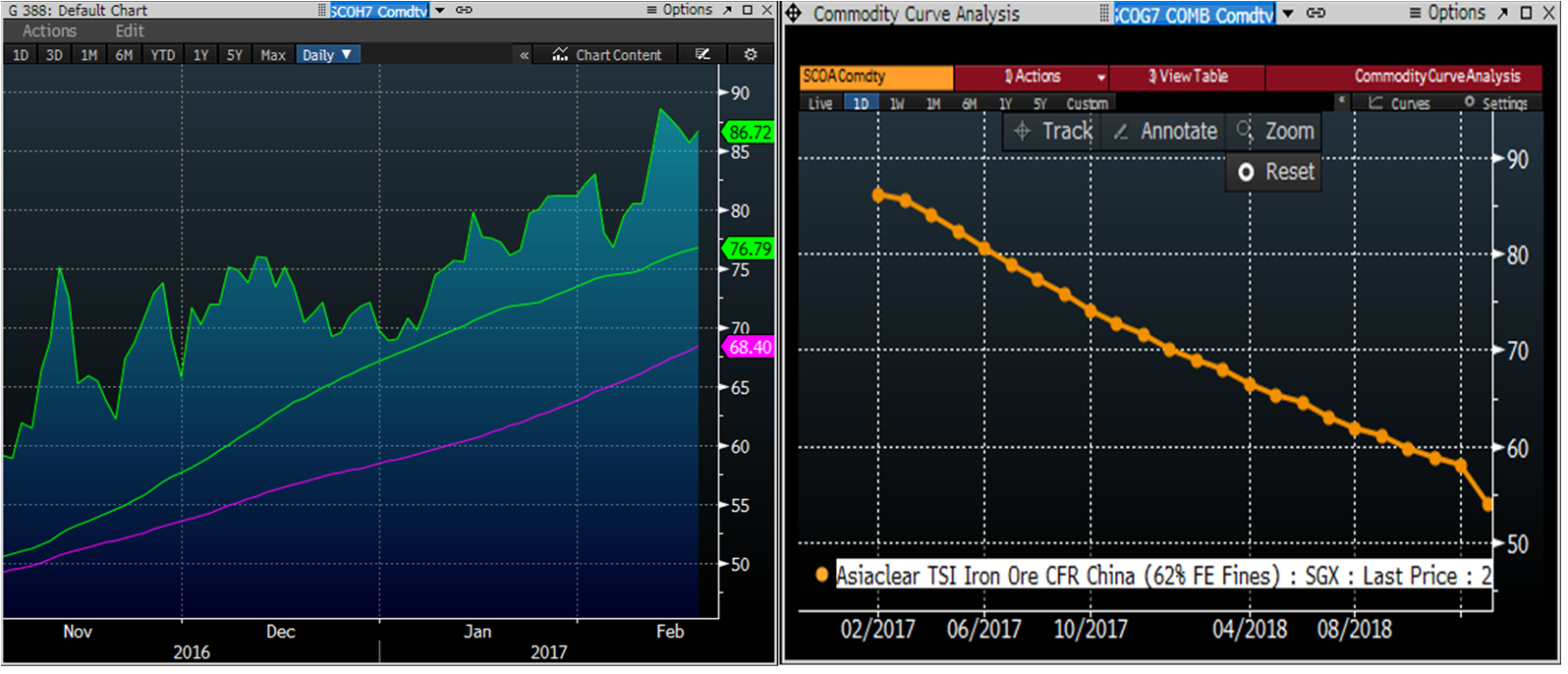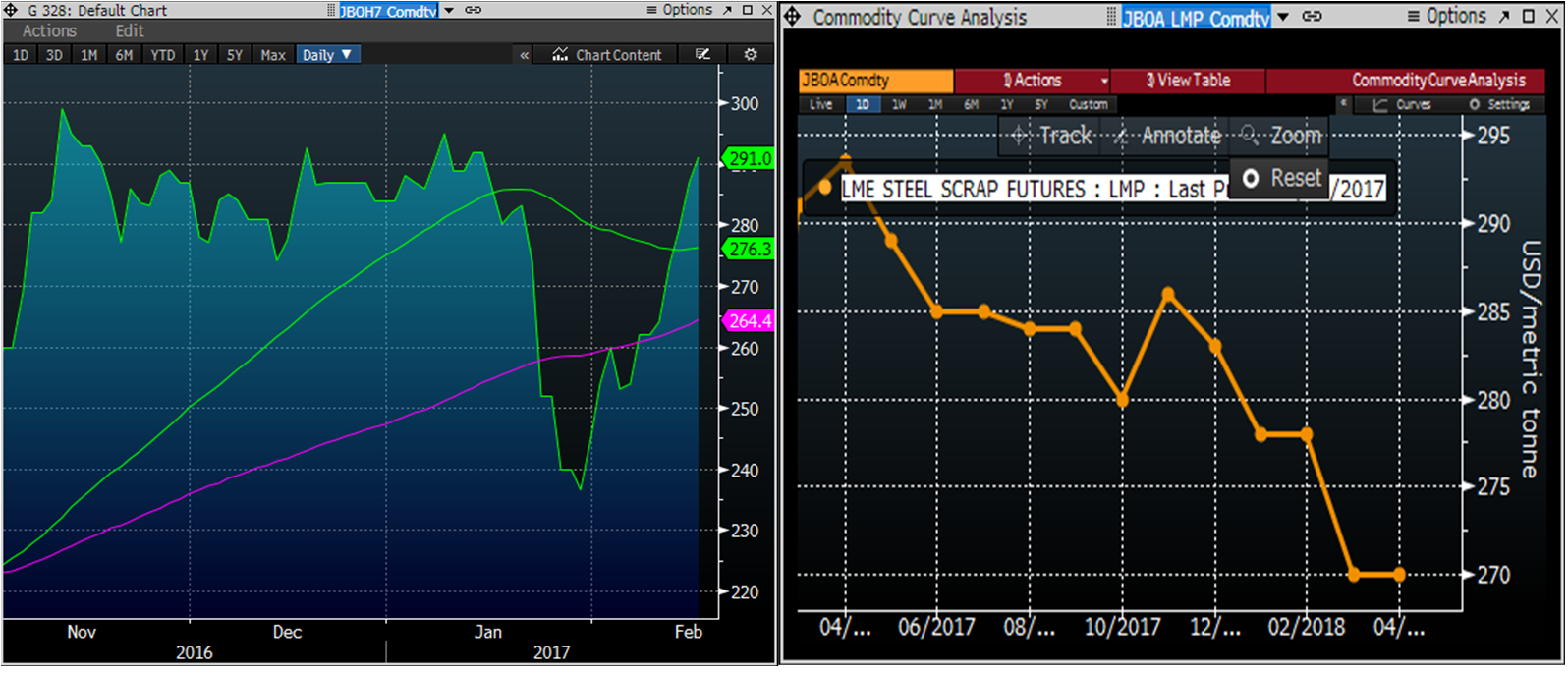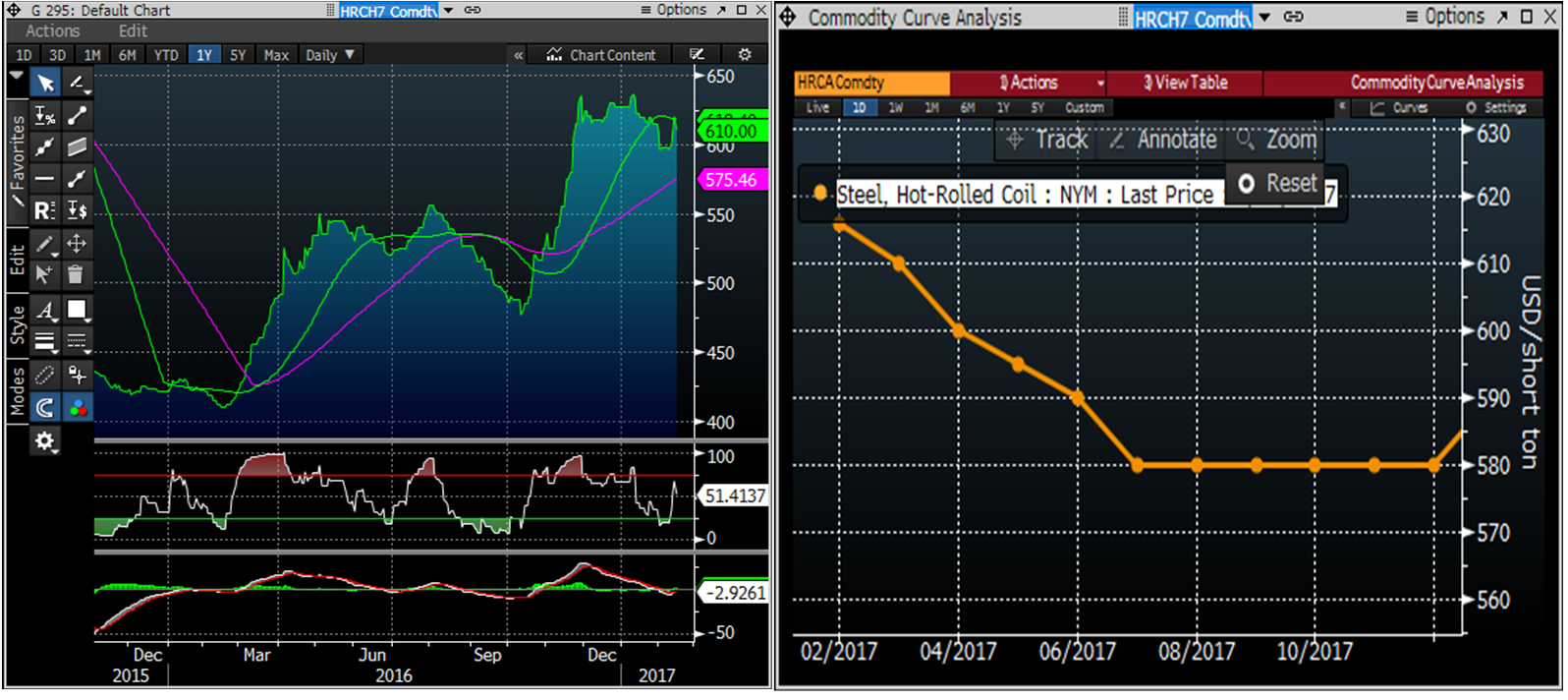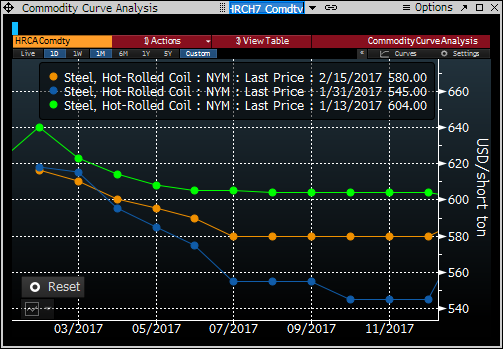Futures

Hot Rolled Futures: Buy The Dips
Written by David Feldstein
February 16, 2017
The following article on the hot rolled coil (HRC) futures markets was written by David Feldstein. As the Flack Global Metals director of risk management, Dave is an active participant in the hot rolled coil (HRC) futures market and we believe he will provide insightful commentary and trading ideas to our readers. Besides writing Futures articles for Steel Market Update, Dave produces articles that our readers may find interesting under the heading “The Feldstein” on the Flack Global Markets website www.FlackGlobalMetals.com.
Iron ore leapt from $80/t to $90/t in two days last week before closing today at $86.72. The chart on the left is the March SGX iron ore future. The chart on the right is the backwardated (downward sloping) SGX iron ore futures curve.
The March LME Turkish scrap futures (below left) closed yesterday at $291/t. The V-shaped recovery in scrap has been nothing short of amazing. In 30 days, scrap fell 19 percent before rallying back to even. What looks to have been a panicked sale of scrap at the end of January quickly reversed as HRC sentiment improved, then Nucor announced that their Louisiana DRI plant would be shut down for five weeks and then Chinese iron ore prices rallied sharply. The LME scrap futures curve is on the right and is also backwardated.
The rebound in scrap prices erased the most obvious bearish factor weighing on domestic flat rolled prices. Strength in iron ore, solid domestic demand data and inventory levels at a multi-year low have boosted domestic flat rolled sentiment. March HRC futures closed at $610/st last night (below left).
The CME Midwest HRC futures curve is backwardated (right above), similar to the curves for the SGX iron ore and LME Turkish scrap futures. Unlike the stock market which sees prices crash down, commodity prices tend to “crash up” due to shortages of the commodity (except last month in scrap). A number of academic research papers conclude that the risk of a commodity’s price “crashing up” correlates well with falling inventory levels. That is relatively low and falling inventory levels increase the risk of a shortage. For many months, the Week-Over-Week Report published at www.flackglobalmetals.com has highlighted the low inventory levels not only in the MSCI flat rolled inventory data, but also across the manufacturing industry as evidenced in the ISM Manufacturing Report and the Durable Goods Report (for a deep dive into the most recent ISM Manufacturing PMI see Week-Over-Week 2/3/2017).
The majority of the time, the shape of a commodity’s futures curve is mostly driven by supply side fundamentals. For instance, the SGX iron ore futures curve has been in backwardation for years due to iron ore’s massive global oversupply. During that time, the Midwest HRC futures curve has shifted between being flat, in contango and backwardated. So is the current backwardation in the Midwest HRC futures curve appropriate?
I would argue it is not. I would say the market is failing to price in the upside risk inherent in what looks to be an undersupplied market comprised of low inventory levels and a lack of actual and potential supply from the import channel. However, much of the outcome will have to do with the demand side of the equation, which appears to be strong and robust.
When Turkish scrap prices collapsed at the end of January, second half 2017 HRC futures also dropped from $600/st on January 13th to $550/st on January 31st (see above). Since then, 2H 17 has rebounded nicely to $580/st and bears watching. If the HRC curve flattens and then moves into contango, it could be the first indication that market participants are becoming concerned that domestic availability is tightening.

David Feldstein
Read more from David FeldsteinLatest in Futures

HR futures: Nucor’s price cut makes its mark on steel markets
When we were asked to provide some additional commentary to SMU about the futures markets for flat rolled, our only reluctance to contribute was rooted merely in the fact that SMU (1) already offers an excellent array of authors on this topic and (2) a concern regarding what new ground could be covered that hasn’t already been discussed to death on this issue. Thankfully, however, Nucor has offered up something we can describe, without hyperbole, as simply revolutionary for spot pricing in flat rolled - a development that we simply could not resist commenting on with respect to its probable impacts on the futures market.

HRC futures: Still waiting for clarity
“One thing we know for certain, however, is that when we write our next column, things will have certainly shaken loose.” – Daniel Doderer, April 4, 2024. Above is a good reminder that whenever someone is “certain” of anything, you should probably look at that line of thinking with a healthy dose of skepticism.

HR futures: Activity muted amid quiet spot market
Week-over-week trading activity in US steel derivatives markets was relatively muted, with prices maintaining their downward direction since the beginning of the month. Bids have materialized at the lower end of this range in the May, as the nearby backwardation continues to roll on - just as we saw with April being a premium over May.

HRC futures: Consolidation ahead of a big move?
It has been a crazy 2024 so far for hot-rolled coil (HRC) futures!!!

HRC futures: A lot of change lurks beneath the surface
It has been six weeks since Flack Global Metals wrote our last SMU column, and if you simply look at the futures curve from then (blue) until now (white), you could argue that very little has changed.




